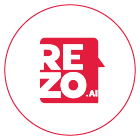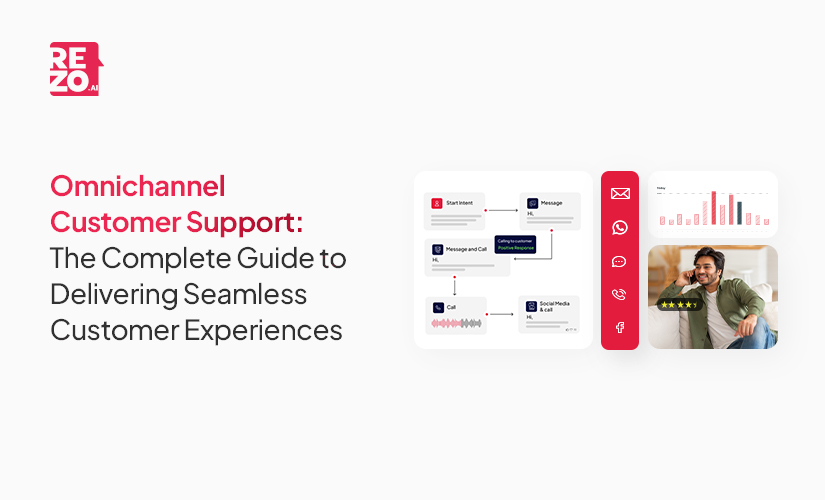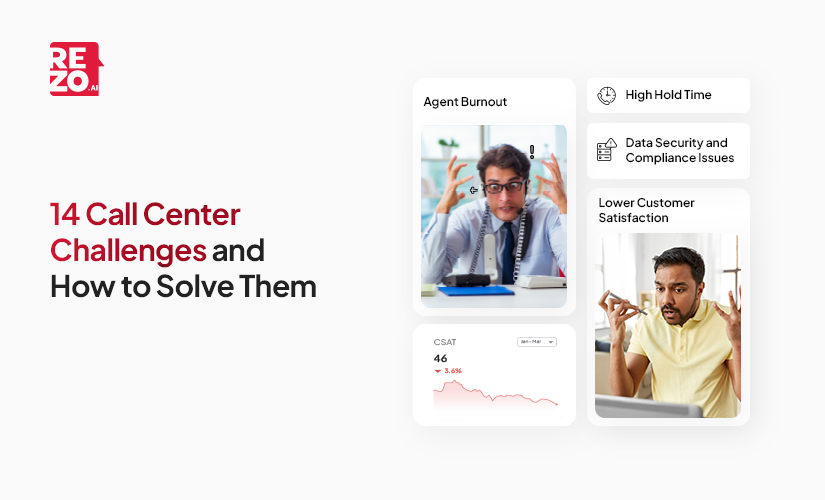
Speech Analytics for Call Centers: Extracting ROI from Every Interaction

Speech Analytics for Call Centers: Extracting ROI from Every Interaction


Every minute, call centers generate a wealth of untapped data. Yet, according to industry reports, less than 1-3% of these conversations are analyzed by call centers.
With speech analytics softwares, organizations are now not just listening to conversations, they’re getting tangible insights out of customer data that can boost ROI by 30%, converting every customer interaction into a strategic asset.
In this blog, we’ll get into how speech analytics is changing the way call centers operate, improving business ROI, and enabling companies for long-term success in the Customer life cycle.
What is Speech Analytics in Contact Centers?
Speech analytics is the process of using AI-powered technology to analyze live or recorded calls, converting spoken conversations into structured, searchable data that uncovers valuable insights about customer needs, agent performance, and business trends.
AI models like Natural Language Processing listen to calls between customer and agent and transform raw voice data into actionable business intelligence that companies can actually use to improve their call center operations.
Core Capabilities of Speech Analytics Software
At its core, speech analytics software's automate the monotonous task of figuring out what's happening in support calls. The AI identifies and categorizes several key elements like:
1. Automatic Speech Recognition (ASR) and Transcription
Converts spoken language from customer calls into accurate, searchable text using Automatic Speech Recognition and large language models.
2. Sentiment and Emotion Analysis
Analyzes the emotional tone and sentiment of both customers and agents, detecting satisfaction, frustration, urgency, or other emotions throughout the conversation.
3. Intent and Topic Detection
Identifies the main purpose of the call (Eg. Complaint, Inquiry, Cancellation) and automatically categorizes calls by topics or recurring issues, enabling trend analysis and root cause identification.
4. Keyword and Entity Extraction
Pinpoints key phrases, product names, competitor mentions, locations, and other important entities within conversations for deeper business intelligence.
5. Real-Time Insights and Agent Assistance
Provides live feedback and guidance to agents during calls, such as suggested responses, compliance reminders, or next-best actions, helping agents resolve issues more efficiently.
6. Compliance Monitoring and Quality Assurance
Monitors calls for regulatory compliance, script adherence, and quality standards, flagging potential violations or risky language in real time or post-call.
7. Pattern Recognition and Predictive Analytics
Detects valuable trends, recurring problems, and correlations such as language patterns linked to customer churn, and forecasts future outcomes using ML.
8. Performance Management and Coaching
Evaluates agent productivity based on conversation analytics, enabling targeted coaching, personalized training, and continuous improvement.
9. Customer Experience Enhancement
Delivers valuable insights into customer needs, pain points, and satisfaction drivers, empowering call centers to proactively improve service and loyalty.
10. Operational Optimization
Streamlines processes by automating call analysis, reducing manual effort, and providing data-driven recommendations for resource allocation and workflow improvements
How does Speech Analytics works in Contact Center?
The process typically involves several key steps:
- Call Recording and Capture: All calls between agents and customers are automatically recorded and stored for analysis.
- Transcription: The recorded audio is converted into text using AI-powered speech-to-text engines, making conversations searchable and easier to analyze.
- Analysis: The transcribed text is used to analyze conversations for compliance, quality assurance, and fraud detection. The system examines keywords, sentiment, intent, and topic categorization. Analysis can also reveal customer preferences, allowing organizations to identify individual interests, needs, and behaviors and tailor their services accordingly. Advanced features include entity recognition (identifying specific products, competitors, or locations) and compliance monitoring.
- Insight Generation and Reporting: Data analysis is performed on the transcribed conversations to generate useful insights and detailed reports, helping managers and agents improve performance, compliance, and customer satisfaction.
Types of Call Center Speech Analytics
Call center speech analytics can be categorized primarily by the timing of analysis and the specific focus of the technology. Here are the main types:
1. Real-Time Speech Analytics Data
- Analyzes live calls as they happen, gives feedback and insights to agents and supervisors.
- Detects customer sentiment, intent, tone and compliance issues in real-time.
- Can trigger alerts, suggest responses or guide agents during the call for better conflict resolution and customer experience.
Good for new agents, high risk scenarios and immediate quality check.
2. Post-Call Speech Analytics Data
- Processes and analyzes recorded conversations after the call is over.
- Extracts keywords, sentiment, agent performance, compliance and call outcomes.
- Enables trend analysis, root cause analysis, quality check and workflow optimization over time.
Good for training, coaching and strategic planning by reviewing large volumes of past conversations.
3. Voice Analytics vs Speech Analytics
- Speech Analytics: Transcribes spoken words to text and extracts sentiment, intent and key phrases using AI and NLP.
- Voice Analytics: Analyzes non-verbal vocal characteristics like tone, pitch, pauses and stress levels to detect emotions and behavioral cues even without converting speech to text.
Both can be used together for a complete understanding of customer interactions.
4. Multilingual and Omnichannel Analytics
- Advanced speech analytics platforms support multiple languages, so you can analyze across different customer bases for better customer service.
- Some solutions go beyond phone calls to analyze text-based interactions (text analytics) including chat, email and social media, for a unified view of customer experience.
5. Predictive and Prescriptive Analytics
- Uses historical call data to predict future trends, customer behavior and potential issues.
- Can recommend actions or changes in real-time or for future calls to optimize outcomes and improve customer satisfaction.
Here’s a quick rundown on the workings of speech analytics:
Complete breakdown of Speech Analytics for Contact Center
Let’s break down the process of speech analytics in Contact Center.
Speech Analytics Contact Center is a technology that enables the analysis of customer-agent conversations, providing valuable insights into customer sentiment, agent productivity, and operational trends.
At the end of the process, organizations should take specific steps to implement speech analytics effectively in their call centers. This includes selecting the right tool, setting clear objectives, training agents, and continuously monitoring and analyzing data for useful insights.
By following these steps organizations can leverage speech analytics to optimize processes and strategies for ongoing improvement.

1. Call Recording and Capture
Every customer interaction is recorded in its entirety, including all phone calls handled by the call center, ensuring a comprehensive dataset for analysis. This step is critical for capturing the full context of each conversation and providing a foundation for all subsequent analysis.
2. Transcription Using AI and NLP
Advanced speech recognition technologies transcribe recorded audio into text. This transcription process is powered by AI and NLP, enabling the system to understand accents, dialects, and even industry-specific jargon.
3. Analysis
Speech analytics focuses on analyzing spoken words and transcriptions to extract useful insights.
Once transcribed, the conversation is analyzed for:
- Keyword and Phrase Spotting: Identifying important terms, compliance statements, or product mentions.
- Sentiment Detection: Gauging the emotional tone of the conversation—whether the customer is satisfied, frustrated, or neutral.
- Topic Categorization: Grouping calls by subject matter to identify trends and emerging issues.
- Entity Recognition: Detecting specific entities such as product names, competitor mentions, or locations.
4. Insight Generation and Reporting
The system compiles the analysis into useful insights and detailed reports, known as speech analytics insights, which can be used to drive measurable improvements in call center operations, coaching, and quality checks. Managers can use these reports to identify training opportunities, improve processes, and ensure compliance.
Real-Time vs. Post-Call Analytics
- Real-Time Analytics: Analyzes live calls, providing agents with immediate feedback and useful insights during the conversation.
- Post-Call Analytics: Reviews completed calls, offering a comprehensive overview of agent performance, customer sentiment, and compliance issues.
Key Features of Speech Analytics Software
Advanced Speech Analytics Capabilities
Modern speech analytics tools do more than just pick out certain words in calls. They use AI and machine learning to dig deep into customer conversations – including what’s said and how it’s said. This means they can find patterns and insights that keyword searches miss.
With these tools, call centers can:
- Discover new problems or trends in what customers are saying.
- See changes in customer mood: growing frustration or satisfaction.
- Catch repeated compliance or rule issues.
These systems can also tie into other business tools like CRM and workforce management. This gives call centers a complete view of customer wants and agent performance.
By using advanced speech analytics, companies can know what customers want and how they feel. This means they can offer more personalized service, train agents better and keep improving the call center.
How Speech Analytics Benefits Call Centers
Speech analytics gives you an edge by allowing you to respond to customer needs and wants.
Speech analytics can analyze huge amounts of unstructured data with ease, they’re super useful for customer experience. By converting every customer conversation into structured, searchable insights, contact centers can quickly find common pain points, understand customer sentiment and spot growing trends.
Let’s get into the top benefits of speech analytics for modern contact centers:

1. Improved Customer Experience
Speech analytics provides a deep understanding of customer needs, pain points, and expectations. By identifying trends and sentiment patterns, call centers can proactively address issues, personalize interactions, and boost satisfaction.
2. Enhanced Agent Productivity and Targeted Coaching
With access to real data from actual conversations, supervisors can use speech analytics to monitor agent productivity and provide targeted feedback. By leveraging speech analytics, supervisors can evaluate each agent's productivity, analyzing individual support agent effectiveness through call analysis and feedback. This enables the evaluation of individual call center agents and their interactions for more accurate assessments. Speech analytics tools can also prompt agents in real time to take specific actions or improve communication during customer interactions. This leads to improved confidence, consistency, and productivity across the team, as analyzing agent's productivity results in more effective coaching and training.
3. Increased Compliance and Quality Assurance
Speech analytics automates compliance monitoring by flagging calls that contain sensitive information or non-compliant language. This reduces risk and ensures adherence to industry regulations.
4. Data-Driven Decision-Making and Operational Efficiency
By analyzing call data at scale, organizations can identify inefficiencies, streamline processes, and make informed decisions to optimize operations.
5. Early Detection of Customer Pain Points and Emerging Trends
Speech analytics enables call centers to spot recurring issues, monitor competitor mentions, and detect emerging trends allowing for quick pivots in strategy and service delivery.
Industry Applications of Speech Analytics
Speech analytics is used across multiple industries to extract insights from customer interactions, improve operations and drive business outcomes. Here are some of the key industry applications:
Contact Centers and Customer Service
- Quality Assurance & Compliance: Automatically reviews and monitors calls to ensure agents follow scripts, meet regulatory requirements and protect sensitive data.
- Customer Satisfaction: Analyzes sentiment and tone to identify unhappy customers and proactively resolve issues, improve overall customer feedback.
- Agent Performance: Provides data driven feedback and coaching to improve agent skills, monitor KPIs and personalize training.
Financial Services
- Fraud Detection & Security: Detects unusual voice patterns or behavior to flag suspicious activity and prevent fraud in real time.
- Compliance Monitoring: Ensures adherence to strict financial regulations and internal policies by monitoring every call for compliance breaches.
Retail & E-commerce
- Customer Insights: Identifies common product concerns, preferences and pain points from support calls, helps to optimize inventory and tailor marketing strategies.
- Sales Optimization: Uncovers upsell opportunities and analyses sales calls to refine sales scripts and improve conversion rates.
Healthcare
- Patient Interaction Analysis: Evaluates patient-provider conversations to improve service quality, monitor compliance and ensure sensitive information is handled properly.
- Training & Compliance: Provides feedback to healthcare staff to improve patient care and meet regulatory standards.
Technology
- Product Development: Analyzes support calls to identify recurring technical issues, guides product development and reduces future support costs.
- Customer Support Optimization: Streamlines support processes by identifying common user frustrations and aligning resources accordingly.
Marketing
- Campaign Effectiveness: Measures customer response to marketing campaigns and analyses feedback to refine strategies.
- Market Trends: Tracks new market trends and customer preferences to inform product development and marketing focus.
Security
- Voice Biometrics: Uses unique vocal patterns for authentication, helps organizations verify identities and prevent unauthorized access.
Best Practices for Implementing Speech Analytics
Choose the Right Platform:
Select an AI-powered speech analytics solution with robust AI and NLP capabilities, and ensure it integrates seamlessly with your existing call center systems.
Set Up Automated Alerts:
Configure the system to flag compliance and quality issues in real time, enabling prompt action.
Use Insights for Training and Process Improvements:
Leverage analytics data to inform agent coaching, process optimization, and customer strategies.
Monitor and Refine Models:
Regularly review and update your analytics models to ensure accuracy and relevance as customer needs evolve.
Foster Agent Buy-In:
Communicate the benefits of speech analytics to agents and involve them in the implementation process to ensure adoption and success.
Remember, speech analytics lies in the misconception that it can reveal all customer insights automatically, human interpretation is still essential to drive meaningful improvements.
Measuring Success with Speech Analytics
Success with speech analytics in contact centers is measured by tracking a range of quantitative and qualitative metrics that reflect improvements in customer experience, operational efficiency, compliance, and business outcomes. Here’s how organizations typically measure the impact and ROI of speech analytics:
Key Performance Indicators (KPIs) to Track:
- Average Handle Time (AHT): Lower AHT means faster call resolution.
- First Call Resolution (FCR): Higher FCR shows more issues solved on the first call.
- Customer Satisfaction (CSAT): Better CSAT scores mean happier customers.
- Compliance Rate: Fewer compliance issues reduce risk.
- Sentiment Analysis: Tracks customer emotions to spot satisfaction or frustration.
- Agent Performance: Monitors how well agents follow scripts and handle calls.
- Cost Savings: Measures reductions in operational costs.
Process for Measuring Success of Speech analytics
- Set Business Goals: Align speech analytics KPIs to your company goals, e.g. customer satisfaction, efficiency, sales.
- Map Metrics to Goals: Choose and track the KPIs that impact your business objectives.
- Analyze and Act: Use dashboards and reports to find trends, root causes and areas to improve. Share insights across teams for continuous improvement.
- Measure ROI: Track tangible outcomes like reduced AHT, improved CSAT, higher FCR, cost savings to measure return on investment.
Impact of Speech Analytics?
Case studies show speech analytics can reduce AHT by 16%, CSAT by 15-20%, compliance by 25%.
Companies using speech analytics see agent performance, customer loyalty and operational efficiency improvements.
Challenges and Considerations
- Data Privacy and Compliance: Ensure your speech analytics solution complies with regulations such as GDPR and PCI DSS, and implement robust data security measures.
- Transcription and Analysis Accuracy: Choose a platform with high accuracy rates for speech recognition and analysis, especially for diverse accents and languages.
- Change Management and Agent Buy-In: Address resistance to new technology by providing training and demonstrating the value of speech analytics to agents.
- Balancing Automation with the Human Touch: While automation enhances efficiency, maintaining a human connection in customer interactions remains essential.
Future Trends in Speech Analytics for Call Centers
- Omnichannel Integration: Combining speech analytics with text, chat, and email analytics for a unified view of customer interactions.
- Advanced AI for Deeper Analysis: Leveraging generative AI and large language models for more nuanced sentiment and intent analysis.
- Predictive Analytics: Using historical data to anticipate customer needs and proactively address issues.
- Real-Time Guidance and Automated Coaching: Providing agents with instant feedback and coaching during live calls to enhance performance.
Conclusion
Speech analytics is transforming call centers by turning voice data into actionable insights that drive customer satisfaction, agent performance, and operational excellence. By implementing best practices and staying ahead of trends, organizations can unlock the full potential of speech analytics and position themselves for customer-centric growth.
Frequently Asked Questions
What is speech analytics in a call center?
Speech analytics is the process of using AI to analyze recorded conversations between agents and customers, extracting insights to improve service, compliance, and performance.
How does speech analytics improve agent performance?
By providing detailed feedback and coaching opportunities based on actual call data, speech analytics helps agents identify strengths and areas for improvement, leading to better customer interactions.
Is speech analytics software secure and compliant?
Leading speech analytics platforms include robust security features and comply with industry regulations such as GDPR and PCI DSS.
What are the most important features to look for?
Key features include accurate transcription, sentiment analysis, keyword spotting, compliance monitoring, and real-time agent guidance.
How quickly can a call center see results?
Many organizations begin to see actionable insights and process improvements within weeks of implementation, with ongoing benefits as the system learns and adapts.
Frequently Asked Questions (FAQs)

Take the leap towards innovation with Rezo.ai
Get started now














